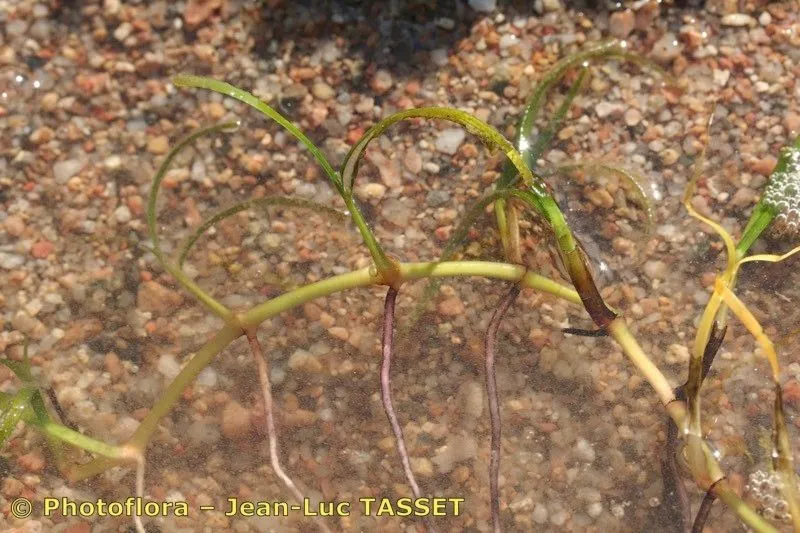
Author: (Ucria) Asch.
Bibliography: Sitzungsber. Ges. Naturf. Freunde Berlin 1869: 4 (1869)
Year: 1869
Status: accepted
Rank: species
Genus: Cymodocea
Vegetable: False
Observations: Medit., Macaronesia to W. Trop. Africa
Cymodocea nodosa, commonly known as slender seagrass, is an essential aquatic plant belonging to the family Cymodoceaceae. This marine angiosperm has garnered scientific attention due to its critical role in coastal ecosystems, particularly within its native range spanning the Mediterranean, the Macaronesian archipelagos, and extending to the western tropical regions of Africa.
First described in the year 1869 in the Sitzungsberichte der Gesellschaft Naturforschender Freunde zu Berlin, this species was scientifically classified by Ucria and later amended by Ascherson, who contributed significantly to its botanical profiling.
Slender seagrass thrives in marine habitats, often found in shallow coastal waters where it can form extensive meadows. These underwater meadows are crucial as they provide habitat and nursery grounds for a multitude of marine organisms, including fish, invertebrates, and even some endangered species. The dense root systems of Cymodocea nodosa play a vital role in stabilizing sediment and maintaining water quality by filtering out particulates and excess nutrients.
Ecologically, Cymodocea nodosa is crucial for maintaining biodiversity and supporting productive fisheries. Its presence indicates a healthy, stable environment, and its decline often signals ecological disturbances. Conservation efforts are particularly vital for slender seagrass, given its sensitivity to environmental changes such as pollution, coastal development, and climate change.
In addition to its ecological importance, Cymodocea nodosa contributes significantly to carbon sequestration, storing carbon in both its biomass and the surrounding sediment, thereby mitigating impacts of climate change. This sequestration capacity has marked it as a focus of interest for environmental conservationists aiming to harness its potential in global carbon management strategies.
Overall, Cymodocea nodosa exemplifies a critical component of marine flora, with its extensive ecological roles and sensitivities underscoring the importance of preserving and studying this remarkable seagrass species.
Eng: slender seagrass
Cat: algueró, nimfa de les aigües marines
Mlt: alka rqiqa
Spa: seba
En: Slender Seagrass, Little Neptune seagrass
Ar: حمول (حَمول)
Ca: Algueró, Nimfa de les aigües marines, Algueró nuós, Cimodocea
Fr: Cymodocée, Cymodocée de mer, Paille-de-mer, Paille de mer
He: גלית גדולה
It: Cimodocea
Mt: Alka Rqiqa
Es: Seba
: Slender seagrass
Taken Jun 10, 2020 by Emanuele Santarelli (cc-by-sa)
Taken Sep 21, 2022 by marash rakaj (cc-by-sa)
Taken Jul 5, 2021 by Emanuele Santarelli (cc-by-sa)
Taken Jul 5, 2021 by Emanuele Santarelli (cc-by-sa)
Taken Jul 5, 2021 by Emanuele Santarelli (cc-by-sa)
Taken Aug 21, 2020 by Sylvain Piry (cc-by-sa)
Taken Jun 10, 2020 by Emanuele Santarelli (cc-by-sa)
Taken Aug 15, 2007 by Photoflora – Jean-Luc TASSET (©)
Taken Aug 15, 2007 by Photoflora – Jean-Luc TASSET (©)
Taken Dec 30, 2007 by Tela Botanica − Christophe GIROD (cc-by-sa)
Taken Aug 15, 2007 by Photoflora – Jean-Luc TASSET (©)
Taken Jan 1, 1970 by Photoflora – L’Abbé COSTE (©)
© copyright of the Board of Trustees of the Royal Botanic Gardens, Kew.
© copyright of the Board of Trustees of the Royal Botanic Gardens, Kew.
© copyright of the Board of Trustees of the Royal Botanic Gardens, Kew.
Ph maximum: 9.0
Ph minimum: 8.0
Light: 7
Atmospheric humidity: 9
Bloom months: [‘apr’, ‘may’, ‘jun’, ‘jul’, ‘aug’, ‘sep’, ‘oct’]
Soil nutriments: 7
Soil salinity: 9
Family: Myrtaceae Author: (F.Muell.) K.D.Hill & L.A.S.Johnson Bibliography: Telopea 6: 402 (1995) Year: 1995 Status:…
Family: Rubiaceae Author: Pierre ex A.Froehner Bibliography: Notizbl. Bot. Gart. Berlin-Dahlem 1: 237 (1897) Year:…
Family: Sapindaceae Author: Koidz. Bibliography: J. Coll. Sci. Imp. Univ. Tokyo 32(1): 38 (1911) Year:…
Family: Asteraceae Author: A.Gray Bibliography: Pacif. Railr. Rep.: 107 (1857) Year: 1857 Status: accepted Rank:…
Family: Fabaceae Author: Medik. Bibliography: Vorles. Churpfälz. Phys.-Ökon. Ges. 2: 398 (1787) Year: 1787 Status:…
Family: Aspleniaceae Author: (Cav.) Alston Bibliography: Bull. Misc. Inform. Kew 1932: 309 (1932) Year: 1932…